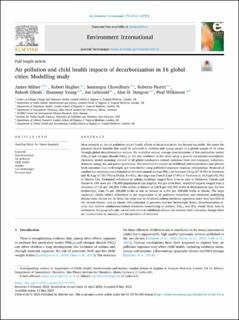| dc.description.abstract | Most research on the air pollution-related health effects of decarbonization has focused on adults. We assess the potential health benefits that could be achieved in children and young people in a global sample of 16 cities through global decarbonization actions. We modelled annual average concentrations of fine particulate matter (PM2.5) and nitrogen dioxide (NO2) at 1x1 km resolution in the cities using a general circulation/atmospheric chemistry model assuming removal of all global combustion-related emissions from land transport, industries, domestic energy use and power generation. We modelled the impact on childhood asthma incidence and adverse birth outcomes (low birthweight, pre-term births) using published exposure–response relationships. Removal of combustion emissions was estimated to decrease annual average PM2.5 by between 2.9 μg/m3 (8.4%) in Freetown and 45.4 μg/m3 (63.7%) in Dhaka. For NO2, the range was from 0.3 ppb (7.9%) in Freetown to 18.8 ppb (92.3%) in Mexico City. Estimated reductions in asthma incidence ranged from close to zero in Freetown, Tamale and Harare to 149 cases per 100,000 population in Los Angeles. For pre-term birth, modelled impacts ranged from a reduction of 135 per 100,000 births in Dar es Salaam to 2,818 per 100,000 births in Bhubaneswar and, for low birthweight, from 75 per 100,000 births in Dar es Salaam to 2,951 per 100,000 births in Dhaka. The large variations chiefly reflect differences in the magnitudes of air pollution reductions and estimated underlying disease rates. Across the 16 cities, the reduction in childhood asthma incidence represents more than one-fifth of the current burden, and an almost 10% reduction in pre-term and low birthweight births. Decarbonization actions that remove combustion-related emissions contributing to ambient PM2.5 and NO2 would likely lead to substantial but geographically-varied reductions in childhood asthma and adverse birth outcomes, though there are uncertainties in causality and the precision of estimates. | en_US |

